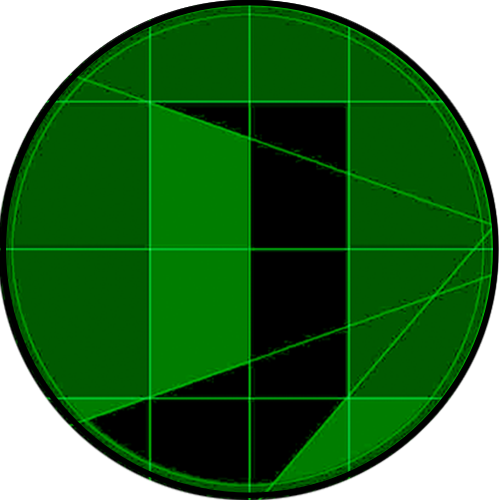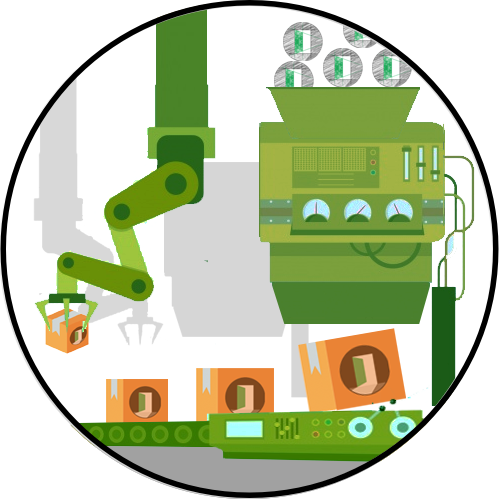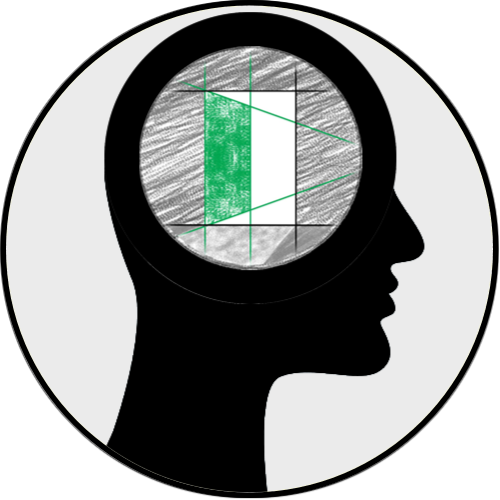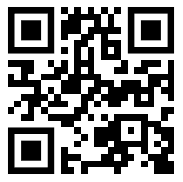The tutorial sessions
The figure below shows the main steps taken in these sessions. I use the Maastritch seven jumps process to explain what happens in a PBL activity cycle.
- Before or at the beginning of the first tutorial session, students clarify the terms and learn the basic concepts necessary for learning in the activity. This can occur with the previous release of didactic material and references for prior study by students, as well as there may be a tutor presentation for this at the beginning of the first session.
- In the first tutorial session, the tutor or one of the students presents the problem.
- The group carry out an analysis of the problem and the data accompanying its description, identifying the knowledge gaps that arise during this step.
- The solution hypotheses (diagnosis) are raised and an action plan is drawn up, with defined learning objectives, to guide studies and research to be carried out.
- The students carry out studies and research necessary to understand the problem and find a plausible solution (diagnosis and prognosis).
- In the second tutorial session, students present their conclusions, advances in learning and discuss the hypotheses raised.
- At the end of the activity, they carry out the evaluations of: cognitive and socio-emotional learning, the tutoring quality, the clinical case, the teaching resources, and any other specified aspect.
Occasionally, as shown below, before the first tutorial session, the tutor might release material for guided study to make the students get prepared for the PBL activity. This ends up resulting in a flipped classroom exercise, in which part of the concepts are previously obtained by the students, through guided study. In the example illustrated below, pre-study material is released on the Wednesday of the week before the first session of the PBL activity takes place.
Now let's present a PBL activity (with two sessions) in detail using illustrations to make it clear how the process takes place in a medical learning activity. We will use the scenario below, with characters that interact with each other, highlighting what happens in an authentic PBL activity.
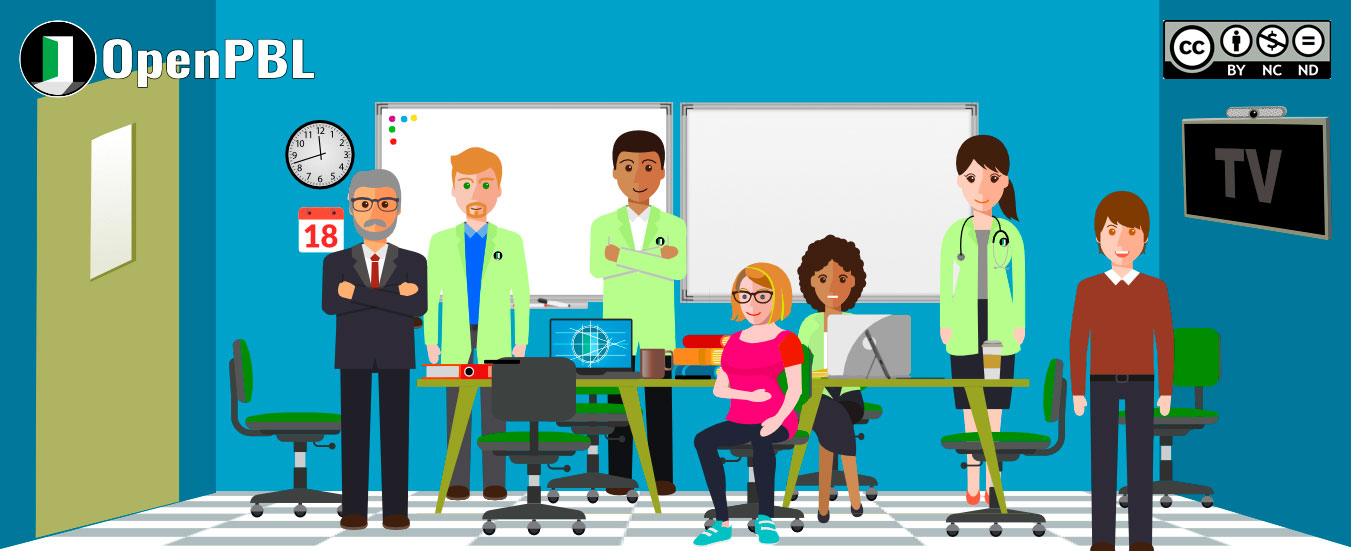
Let's start our "storyboard" with the first session, presented below.
First tutorial session
Problem presentation
In the first session, two of the students are chosen to take on key roles in the PBL process: the leader and the writer. The choice can be made randomly, based on volunteerism, but it can also be done in a systematic and planned way. By doing so over the different PBL activities, the positions of leader and writer are alternated between students, so that everyone can play these roles. After all, the ability to organize everyone's participation (leader's role) and to organize the information collected on the board (writer's role) are also competences to be developed among students.
Good morning. Let's start the first PBL tutorial session. Who will be the leader today? And who will be the rapporteur?
Today it is my turn to be the leader.
I can be the writer.
Alex, can you read the case today?
Sure! Let's see it on the monitor.
A 25-year-old male presented with diplopia, dysphagia, and unresponsive dilated pupils. The patient also presented with diarrhea…
The leader is the student who receives the description of the clinical case of the PBL activity, normally using the aforementioned PBL activity notebook. This leader can delegate to another person the reading of the clinical case, as an intrinsic part of the leadership that he must exert in the session. To conduct the tutorial session, the leader must ensure that there is time for each of the colleagues to speak, managing the conflicts of opinions, controlling the use of time, encouraging those who are silent to participate in the activity, among other duties of the organizer of the session. Note that by taking on this responsibility, this student exercises important skills beyond leadership, such as conflict management and time tracking. Besides, these competencies might be observed by the tutor for assessment purposes.
Let's start with terms that are unfamiliar or difficult to understand.
I did not understand what diplopia and dysphagia are.
I also did not understand what dysphagia is.
I confess that I don't know what "descending paralysis" means.
Work of the writer
The second elect is the writer, who will use the whiteboard, blackboard, or flip chart, to write down and organize all the information coming from the participants during the session. He/she will write the main data present in the description of the clinical case, as well as questions, possible diagnoses (hypotesis), necessary clinical exams, concepts to be studied, among other information raised by the group.
Ludmila, let's start listing the terms?
The terms raised are already written on the whiteboard.
Thanks. Does anyone know any of these terms?
Descending paralysis occurs when muscle paralysis that first affects the upper part of our body before reaching the lower part.
Thanks Alex.
Does anyone know the other terms?
[Silence] Apparently, I don't think so!
I am going to organize the whiteboard.
Then such terms will be included in our learning objectives.
By writing everyone's insights on a board, the writer allows anyone in the group to reflect on the points that are raised at all times during the session. Information posted on the board may also be changed, emphasized, and deleted as discussions progress with reflection and debate about what is posted. Note that by taking on the role of writer, the student ends up exercising organizational skills, speed and clarity in structuring ideas in a framework whose content is influenced by everyone in the group.
Problem analysis
Did you notice, by obseving the cartoons, that the tutor was apparently without an active role in the process? It is true! In a PBL session, the tutor is only a facilitator, not a process director. The learning process is student-centred, not tutor-centred. However, occasionally there is tutor intervention, as shown below. He intervenes when an approach is made that goes against the learning objectives of the activity.
I think our patient may have Guillain-Barré or Miller Fisher syndromes as possible causes.
That's right, I think it could be botulism or neuroblastoma.
Congrats guys, you're on the right track. I would just like to add that we are not going to cover any cancers in this tutorial.
Please, erase this item from the list.
Hugo, do you have something to suggest?
Note that the tutor is constantly evaluating student participation, both in cognitive terms (accuracy, reasoning, correctness, etc.) and in socio-emotional terms (initiative, communication, moderation in interventions, etc.). This evaluation will compose the grade of each student at some point in the PBL activity.
While the reader presents the clinical case, the writer places the main data on the whiteboard for all to see. In institutions that are better technologically equipped, the description of the clinical case can be published on the large monitor. It is even possible to show images of exams, recordings of the anamnesis made with the patient (recording of a fictitious consultation, made with an actor).
Note that access to the clinical case only at the time of the tutorial session allows the tutor to understand who was previously prepared to deal with its complexity. That is why in many cases, although there is the possibility of students receiving the clinical case data in advance, this usually only occurs during the first tutorial session. What can be anticipated for students is just theoretical reading without specifying the case in which the concepts presented in such a directed study will be applied.
Request for medical exams
Students may also consider "ordering" lab/clinical tests. Certainly the case book will have the fictitious exam results if it makes sense to ask for it. So the reader can share the exam result immediately with everyone else. As you can see below, as soon as a student raised the need for a specific exam, the reader or the tutor reads the exam result to be written on the whiteboard.
Well, I believe our hypotheses are sufficient, how about we order some tests? I suggest performing blood tests for botulinum toxin and anti GM1 and GQ1b, in addition to antibody research for Campylobacter jejuni
Clinical examinations of the case book demonstrate that there was a weak response to botulinum neurotoxin-B, but anti-GM1 and GQ1b were negative. Having said that, I think we can then see what subjects or themes need to be studied in order to solve the problems.
As the brainstorm evolves, the tutor asks questions about important aspects that were not mentioned by the students. Occasionally, when a knowledge gap is identified, it is noted in the list of learning issues. This list will guide the research and study efforts to be made after the first tutorial session.
Therefore, we can add: “definition and clinical picture of botulism, Guillain-Barré or Miller Fisher syndromes”
If applicable, we may include “treatment for different types of botulism”
Questions and hypotheses
During the session, students seek to raise hypotheses that can lead to a differentiated diagnosis, to the identification of the disease that causes the problem. As they explore the patient's history, data from the physical examination and laboratory tests. Thus, they can add possible hypotheses and discard others previously raised. Meanwhile, the writer continues to document all decisions taken on the whiteboard.
The whiteboard is up to date and organized.
I think we already have our homework set. Let's study and at the end of the week we will meet to discuss and try to solve this problem!
Study and learning plan
And so, the trigger problem serves as a basis for students to ask questions about the patient's situation, identifying other problems even more critical than the one initially presented for the case, as it happens in the real world. Questions and discussions end up refining the list of differential diagnoses.
This ends up eliminating some hypotheses and reinforcing others as a possible diagnosis of the problem. At the end of the first session, we have a list of hypotheses and actions needed to confirm or discard them, based on research and studies to be carried out by students.
At the end of the first session, students copy the notes made by the writer and move on to study and research the points listed as learning objectives.
Note: The whiteboard above is just a very simplified representative figure of the notes made by the writer, it is not intended to specify a standard or scope of the annotation needed for the PBL activity.
Between sessions
After identifying learning problems, students begin self-directed research and study to learn as much as possible about the learning objectives listed in the action plan. The sources of information are diverse: books, periodicals, reports, online information and even subject matter experts related to learning issues. Such work can be done individually or in groups of colleagues. Thus, each student develops skills such as initiative, teamwork, collaboration, information search, speed reading, time management, among others.
Second tutorial session
The second tutorial session begins with reading the activity problem. Each student discusses with their peers about the learning issues or knowledge gaps raised in the first session. They present what they studied and learned in-between the sessions. Then, they analyze the problem again, this time with the new knowledge gained through the research and studies carried out since the first tutorial session. As a result, they must demonstrate a better understanding of the problem, being more assertive and precise in presenting a solution to the problem (diagnosis and/or prognosis of the case).
Let's start the second session. Remember that the objective of the second tutorial meeting is to integrate the information brought, to solve the problems of the case. You can start.
Okay, Laura, can you remind us of the issues that our group identified in the last session?
Of course. They were: “How to make the differential diagnosis between botulism, Guillain-Barré or Miller Fisher syndromes?”, “What is the best treatment for our patient?”
Perfect. Would anyone like to start the conclusions we reached?
Me! Well, the term “diplopia” is “double vision” and “dysphagia” is “difficulty swallowing”. Also, based on my studies, Guillian-Barré syndrome is an autoimmune reaction that affects the nerves and leads to muscle weakness...
... However, an interesting thing is the pattern of paralysis is ascending in the patient and not from top to bottom as in this case!
As you can see below, everyone is free to use whatever resource to share the knowledge they have gained: flowcharts, concept maps, YouTube videos, articles, PowerPoint or similar. However, communication must be precise, synthetic, and based on scientific concepts learned from the PBL activity.
That's right! It is worth noting that Miller Fisher syndrome is actually a variant of Guillian-Barré, which is characterized by a classic triad of symptoms: ophthalmoplegia, ataxia and areflexia. Just as Hugo said, not very consistent with the patient's condition!
Great! Laura, do you want to add something?
Yes. In my studies I found botulism is a disease caused by a neurotoxin produced by the bacteria Clostridium botulism...
...It causes symptoms very similar to what the patient has including pupil dilation, descending paralysis, diplopia and dysphagia! Reinforcing the diagnostic hypothesis of botulism and not of other syndromes!
That's right! It is worth noting that Miller Fisher syndrome is actually a variant of Guillian-Barré, which is characterized by a classic triad of symptoms: ophthalmoplegia, ataxia and areflexia. Just as Hugo said, not very consistent with the patient's condition!
Look, then we can rule out the possibility of Guillian-Barré and Miller Fisher syndromes based on the clinical picture and laboratory tests, since the patient had negative results for anti-GM1 and anti-GQ1B antibodies.
I believe we are left with the hypothesis that our patient suffers from botulism.
Guys, I looked through my microbiology books and I believe I found the answer. We must treat him with antitoxin!
At least in the healthcare area, there is not necessarily a right or wrong answer to solve the problem, which is a health issue. What is important is that the answers given by the students have a scientific basis clearly communicated in each one's narrative. Even in the case of the last session, there is still room for debate, for the contradictory, for conviction. This intense interaction between students, under the supervision of the tutor, is what makes the PBL methodology so rich in learning outcomes.
Oh! But any antitoxin?
I think we should use one that acts on all types of toxins that bacteria of this type can emit. I believe it's called "heptavalent equine botulinum antitoxin"
Great! Any personal questions? Did Ludmila manage to write everything down?
Yes, I'm done.
Congratulations to all of you! I'm impressed with the work you're doing. Keep it up always!
We will close the session with the activity and learning assessment procedures.
Once everyone has reached an understanding of the solution (diagnosis and/or prognosis) considered more adequate, the group can close the discussion on the case. This includes the guidelines to be given to the patient and even details about the treatment to be carried out, if applicable.
Assessment
Ideally, the learning assessment should involve both cognitive and socio-emotional skills, as explained in this text. As long as it involves lots of details, let's approach it in the next page.



